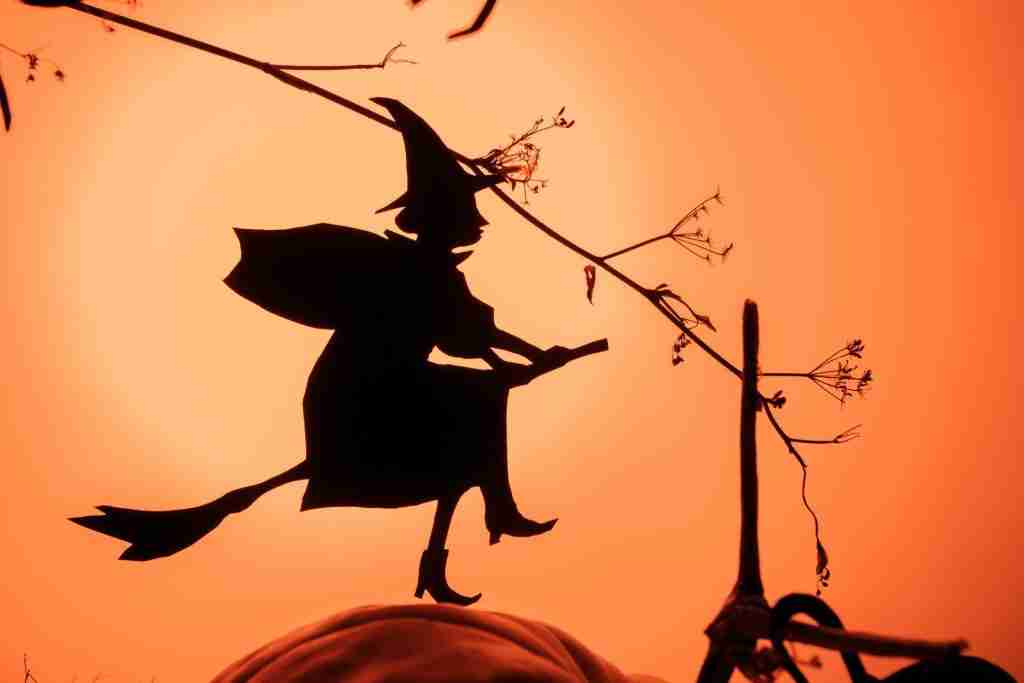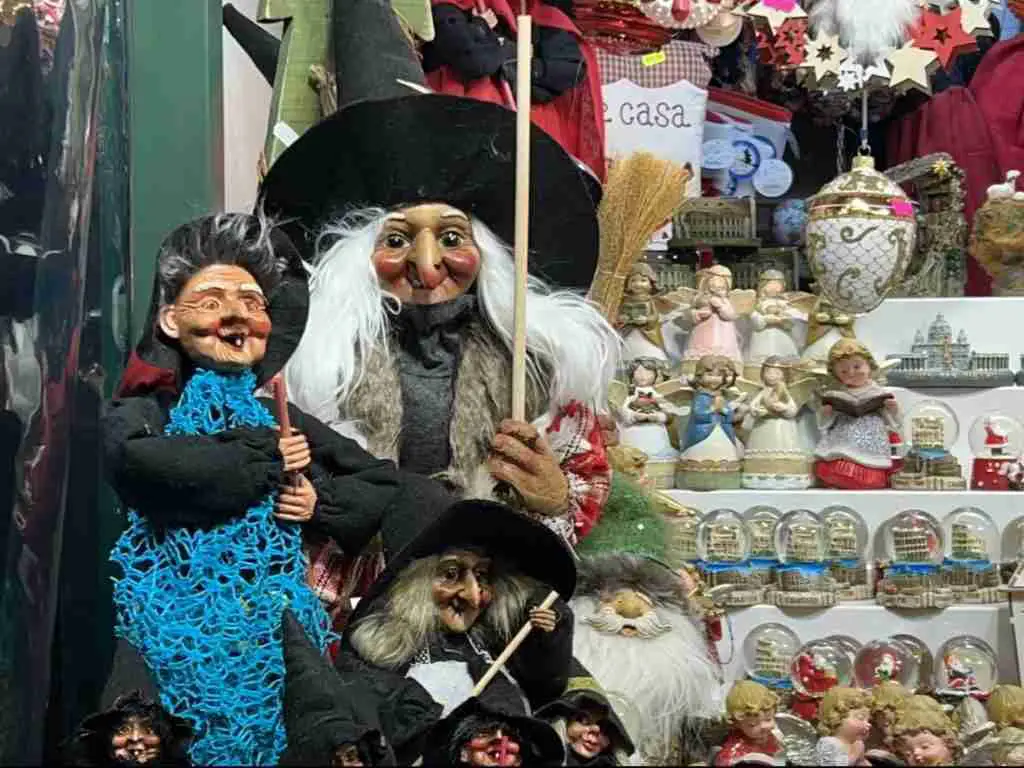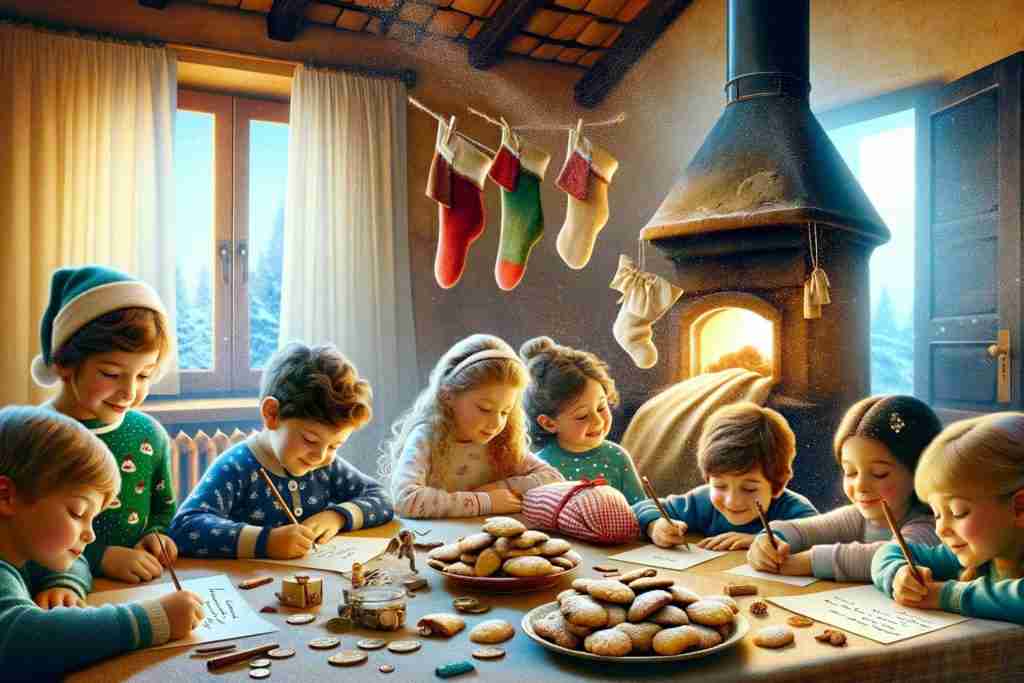Across Italy every January 6th, a beloved holiday celebrates the visit of the Three Magi to the baby Jesus. Known as the Epiphany or Little Christmas, this joyous day also marks the more mysterious flight of La Befana, a magical Christmas witch who swoops in on her broomstick across the night sky to leave presents for good Italian children. From nativity plays to pillowcase gifts to regional sweets and festive markets, the Italian Epiphany brings its own unique traditions tied to this major Catholic feast day. Come along as we explore the origins, folklore, food, and timeless customs that color Italy during the early days of each new year! We will discover the Epiphany celebration and the myth of La Befana in Italy.

The Epiphany celebration: holiday steeped in ancient history
The origins of Epiphany celebrations trace back to the Eastern Church, where it initially encompassed the birth of Christ. However, by the 4th century AD, calendar adjustments had shifted Christ’s birth to December 25th. Consequently, the Roman Church started honoring January 6th as Epiphany. The word “epiphany” derives from Greek, meaning “manifestation or appearance.” For Christians, it refers to God incarnating in human form through Christ’s birth. But well before the life of Jesus, ancient midwinter celebrations had significance tied to rebirth and light returning after winter’s long darkness. The date now belonging to the Christian Epiphany corresponded to already existing Roman and pagan winter solstice festivities honoring gods like Saturn. When Roman Catholicism eventually dominated Italy, the Church assimilated certain solstice symbols, traditions and meanings into the Feast of the Epiphany. So, while on its surface, Epiphany focuses on the Magi’s realization of Christ’s divinity, the holiday retains echoes of millennia-old rituals welcoming longer days, renewed vegetation, and human resilience even through the harshest winters. Thousands of years on, mid-January still brings that hopeful underlying theme to what has evolved into a major Italian holiday infused with sweets, gifts, and charming folk characters.
The Epiphany celebration: marking the end of the holiday season
For most western Christians, the twelve days of Christmas extend from December 25 all the way to January 6 on the day of the Epiphany. During this period, nativity scenes remain on display in homes, churches and town squares across Italy. In the past, no Christmas trees or decorations would come down until after the 6th when the Epiphany officially closes out the holiday season. Of course, modern life means that practice may shorten for some busy working families. Still in many households, Italian kids must patiently wait until the arrival of “La Befana” before finally dismantling the tree and ornaments. The Epiphany signifies a last hurrah to usher out festivities in a big way before Italy returns to workaday routine. There’s a final celebratory mood in the air during this transitional period between leisure and normal schedules resuming around the 7th.

The myth of La Befana in Italy: sweet treats take center stage
A feast for the sweet tooth takes place across baker cases in early January with specialty seasonal confections. One particular Epiphany dessert have center stage, the fruity Torta della Befana. Torta della Befana is a moist, towering Bundt-style ring cake covered in dark crumb chocolate coating or often, powdered sugar resembling drifting snow. Fillings feature chocolate chips or dried fruits like raisins, citrus zest or cherries. Almonds, another popular ingredient, symbolize coins the old witch La Befana distributes to well-behaved children on her feast day night. Special delicacies for La Befana also include ‘sweet coal,’ petite cookies named ‘befanini,’ and the Befana cake, containing a hidden dried bean. The lucky individual who finds the bean in their slice is declared the king or queen for the day. Beyond just these signature Epiphany cakes, bakeries tempt customers with chocolates, traditional holiday panettone and pandoro served alongside Italian hot chocolate, coffee and tea. Sweet breakfasts and after dinner treats sustain Italians through the early dark winter days.

The myth of La Befana in Italy: vibrant Markets and Decorative Lights
In the weeks between Christmas and La Befana’s arrival January 6th, open-air markets brighten town squares across cities and villages in Italy. The glowing stalls overflow with handmade clothes, toys, holiday ornaments, candy and carnival masks—a preview of Venice’s famous Carnevale festival gearing up in February. Shoppers stock up on decorations at discounted prices for next Christmas or purchase last minute gifts aided by a hot mug of mulled wine or vin brulé. Strings of mini light bulbs criss-cross above in the shapes of stars or glowing icicles, casting a cozy atmosphere to combat brisk weather as families stampede the stands, voices rising in laughter together. Regional bands play familiar carols as the aromas of roasting chestnuts and baked Panettone fill the air at these enchanting Italian Epiphany fairs.

The myth of La Befana in Italy: finding La Befana at stall markets across Italy
From late December through the first week of January, Piazza Navona in Rome transforms into a crowded, chaotic open air market paying homage to La Befana in anticipation for her festival night. Hundreds of stands sell toys, ornaments, candies and bonbons with vendors calling out deals over classic holiday tunes piping through old stereo speakers. Children weave glowing fairy wands through the crowds as parents stand in line waiting for paper cones overflowing with hot, roasted chestnuts or crispy rings of fried dough topped in sugar. At the heart of the market a giant icicle-strewn stall called Casa della Befana serves as the Christmas witch’s official post where families pose wide-eyed tots before the life-size La Befana statue. Letters to the old witch drop through a red letterbox slot so Italian children can personally request gifts like bicycles, baby dolls or toy Ferraris to appear in their stockings come Epiphany night.
The Epiphany celebration: Bolzano Christmas Market
The Sudtirol region’s capital lies nestled at the start of the Italian Dolomites mountains where the German influence remains strong. Bolzano’s Christmas market transports visitors back to classic European styling with its handsome wooden cabins adorned with evergreen swags and red ribbons. Here alpine ski souvenirs share retail space with nutcrackers, smoked speck hams and cheeses like Asiago and pungent mountain Fontina. Hearty potato pancake stands dole out crepe-like treat Schlutzkrapfen alongside mugs of mulled apple juice or alcoholic Eierpunsch punch with notes of vanilla, eggs and rum. Candy stalls painted like quaint Tyrolean cottages, sell foil-wrapped chocolate La Befana bells and tiny edible witches on brooms guaranteed to delight kids under twinkling white lights. As the sun sets the shadows from the craggy Dolomites loom over the market while the illuminated Ferris wheel spins for a ride showcasing this unique seasonal celebration at Europe’s northern edge.
The Legendary Story of La Befana
Like Santa Claus, Italians far and wide grow up hearing the tale of La Befana, a wizened old witch dressed in black rags, flying across the sky on her broomstick each year on Epiphany Eve. This iconic fairy tale figure captures beloved characteristics of the holiday season – family, faith, generosity along with a touch of mystery and magic. The name Befana likely derives from a mispronunciation of the word “Epiphany” over the ages. The rest of her backstory draws upon pre-Christian myths about elderly pagan goddesses overseeing fertility, light and the new year. When Christianity dominated the land, these feminine spirits blended into what we now know as the good-hearted Christmas witch. In popular legend, Three Wise Men stopped at La Befana’s house following that bright legendary star in the East but she was too busy cleaning to join the Magi’s journey. Later when she tried catching up, Befana got lost and instead wanders the world on her drifting broomstick forever trying to find baby Jesus on that long ago night. Initially hesitant, Befana later regretted her decision and sought the manger. Failing to find Jesus, she instead distributed her gifts to other children. Now, every year on January 5th, she rides her broomstick, continuing her search for the manger and leaving presents for children who set out shoes or stockings on Epiphany Eve. This tale, emerging in the 13th century, was initially prevalent in Rome and nearby areas but has gained nationwide popularity in Italy over the past century. To reward well-behaved kids while punishing naughty ones, she flies down chimneys delivering cases stuffed with candy charcoal or toys and treats to fill little boots left by beds or balconies overnight between January 5th and 6th. Eager young Italians pen her earnest letters and set out stockings or even pillowcases hoping La Befana’s generously-packed sack magically drops down their homes’ sooty flues. Long after morning light, evidence remains scattered about in the forms of crumbs from almond cookies shaped like coins, candy stuffed in little socks, or the witch’s telltale soot.

The Epiphany celebration: nativity plays, services and superstitions
Whether attending mass, watching an entertaining presepio play or making predictions for the new year, Italian families, couples and friends come together to mark the important Epiphany feast day on January 6th. In the faithful South, many worshippers attend church to bless chalk and charcoal, representing the three Magi’s valuable gifts for the Christ child in Bethlehem. After the priest consecrates the materials, congregants take home the objects to safeguard against storms, fires and evil spirits in the coming year. Especially across Sicily and in Southern regions of the mainland like Puglia or Campania, communities perform dramas and original plays bringing Bible scenes to life with local flair and humor. These reenactments of Mary, Joseph’s journey and the Magi‘s fatefulmeeting with the infant Jesus often depict the weary horse-mounted Three Kings in search of some home-cooked pasta after their long pilgrimage! Lively musical numbers, exaggerated mannerisms and comic pastoral characters like shepherds and angels all comprise the traditional Italian presepio performance to honor the Epiphany in theaters and village squares. Superstitious people also believe that clues about the year ahead hide in the first few days of January. The weather on La Befana’s big night indicates whether winter will stretch on a few more months or an early spring thaw can be expected. Others examine signs from nature like the patterns of onion skins or fig seeds broken open on morning of the 6th to interpret the year’s destiny concerning business, love, or migrations.
Ancient Pagan echoes
While bright colors, gifts, feasting and lights burst across Italy between Christmas and the Epiphany, a few regional pockets still reveal Europe’s pre-Christian pagan roots through ancient January rituals. Up in the Northern Trentino Alto-Adige mountain towns, loud spooky noises clatter through the streets on January 5th as processions of masked characters chase away spirits of darkness to mark the unofficial start of Carnival season. Hordes of bearded Perchten creatures dressed in shaggy sheepskins with grimacing wooden masks and headdresses stalk from farm to farm, clanging their cowbells loudly while families cower and laugh. Led by torchlight, these frightening mythic beings are believed to clear misfortune and trouble from villages over the coming months following their frightening nocturnal march. Further south, Calabria stages La Festa di Sant Antonio Abate on January 16th and 17th where fires burn to purify livestock through smoke and saints join forces with witches according to old regional folk beliefs. Italy blends many traditions both sacred and pagan to form its own unique soulful character stretching across history.
Guests arrive early on Epiphany Eve
At dusk on the 5th of January, Italian children watch the horizon for the silhouette of La Befana astride her broomstick or spy a lucky shooting star streaking past as midnight nears. After hanging their longest stockings or handmade decorative pillowcase at the foot of beds, tired young ones try their best to fall asleep. Accounts tell of stubborn little ones sprinkling dark semolina flour across floorboards to catch the faint markings of La Befana’s footsteps before faded come daylight. Eager young guests snooze over at Nonnas’ houses to maximize their gifts with additional stockings at the ready come morning. But before the household stirs, the magical witch herself must alight upon the roof tiles and squeeze her way down narrow chimneys across Italy, hoping not to get her black rags singed by dying coals. Quiet as can be, she dusts off leftover ashes and fills waiting boots and stocking cuffs with girly hair clips, racecars, rainbow lollies – rewards for polite children to discover joyfully in just a few hours more.

After La Befana’s departure, the holidays officially conclude
Dawn inches across frosty window glass and winter birds awaken in bare branches just as wide-eyed Italian children wake to presents from the nighttime visit by La Befana. Rustling pillowcases and bulging socks spill toys, trinkets and Italian chocolate gold coins onto quilts and carpet amid Christmas trees standing slightly less adorned in the soft glow. Parents like to tease about any candy charcoal left behind for whiny, unhelpful kids while the family prepares hot chocolate and breakfast. But as the winter sun rises higher and distant church bells beckon midday mass attendees, the warm nostalgic candlelight of another holiday season begins to dim. By nightfall of il giorno della Befana, hearty dishes like roasted pork shanks, lentils and red wines are passed around long candlelit tables amid laughter recounting holiday memories from weeks prior. And one by one, sparkling lights wink out across eaves, stair boughs and high city flats. Doors close as chilled air sharpens and families nestle inside their homes once more, warmed by the flames and food that anchors their Italian soul. Babbo Natale’s sleigh bell echoes fade as the soundless old witch stows her broomstick for a future flight until the next frozen starlit eve.

